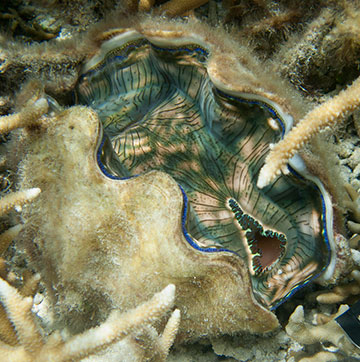
A symbiotic relationship between giant clams and single-cell algae enables the iridescent mollusks to convert sunlight into chemical energy with near-perfect efficiency. [Image: Yale University]
A new study suggests that more efficient systems for biofuel production could be engineered by copying the energy-generation strategies of giant clams living in the coral reefs of the Western Pacific (PRX Energy, doi: 10.1103/PRXEnergy.3.023014). By modeling the optical processes inside these iridescent mollusks, the researchers hope to inform the design of sustainable biorefineries that are powered by natural sunlight.
Better algae cultivation
While the industrial bioproduction of single-celled algae offers one of the most promising sources of renewable fuels and chemical feedstocks, widespread commercialization has so far been hindered by low light-conversion efficiencies. But lead author Alison Sweeney, Yale University, USA, believes that better cultivation strategies could be inspired by giant clams, which are able to convert incoming sunlight into chemical energy with near-perfect efficiency.
The clams are covered with a thin layer of light-scattering cells, called iridocytes, that direct sunlight onto cylinder-shaped tissues inside the mollusks. This light is absorbed by single-cell algae that grow in vertical columns along the cylinders, with both the geometry and the light-scattering process ensuring that the algae receive the optimal dose of illumination.
Putting clam-like geometry to the test
To quantify the efficiency of this scheme, Sweeney and her colleagues created a physical model of a solar-energy transformer with a clam-like geometry. In an idealized case that assumes the algae are evenly distributed around the cylinders, their model initially calculated a solar-conversion efficiency of 42%―much lower than expected from actual observations.
However, updating the model to account for the way that clams move as the light conditions change yielded a much higher efficiency of 67%, which agrees with the lower end of the experimental data. Monte Carlo simulations that better reflect the columnar growth of the algae produced similar results, suggesting that the simplified model offers a good approximation that could also be applied to other biological systems with similar structural features.
The researchers suggest, for example, that their model could explain why conifer forests absorb more sunlight than their broad-leaf counterparts.
Model insights
The researchers suggest, for example, that their model could explain why conifer forests absorb more sunlight than their broad-leaf counterparts. In this case, the individual trees perform the same structural and optical functions as the algal columns, with fluctuating layers of cloud and fog exhibiting similar light-scattering behavior as the irodocytes.
More generally, however, the model could offer important insights for exploiting algal cultivation as a renewable energy resource. “A large system that follows the physical principles that we have outlined for the clam could in principle exceed a biofuel productivity of 60,000 liters per hectare per year,” notes Sweeney.
